
Weight and Balance
System and Message Overviews
Document Version: 6.0
Date: March 3, 2014
Document Revision History
The following revision history table reflects all substantive changes to this document.
| Date | Description of Updates Made |
04-August-08 |
No changes since previous release. |
| 01-October-09 | Updates to WB001 and WB002. |
| 31-March-10 | Created new versions of WB001 and WB002. Added new message WB003. |
| 14-July-10 | In WB002, added the optional maxTakeoffWeightLoadPlanSystem. Added new messages WB004 and WB005. |
30-August-10 |
Updated links for new Bookshelf directory structure. Updated WB002, WB004 and WB005. |
22-October-10 |
Updated WB004. Added scheduledTimeOfDepartrue; estimatedCargo, estimatedPaxNumber; maximum landing weight. Added to both request and response. |
| 18-November-10 | New XSD. |
| 8-June-11 | New XSD. Updated message WB005. New message WB006. |
| 30-August-11 | New XSD. Updated message WB004 to add new boolean value to indicate if the WB004 request is for the estimatedZFW or a Load Plan calculation. Add new data to communicate CofG graphic details WB004 response – flightEnvelopes |
| 15-November-11 | New XSD. Updated message WB003 - Add optional attribute of basicWeightUom to ActualDepartureFuel. New message WB007 Actual Arrival Fuel. |
| 17-February-12 | New XSD. Updated WB003 to add optional user:info, userName, userLocation. |
| 15-November-12 | New XSD. |
| 26-February-13 | New XSD. Removed "nillable" from dryOperatingWeight, zeroFuelWeight and all other weights within the WB002. |
| 23-July-13 | New XSD. |
| 3-March-14 | New XSD. |
Table Of Contents
1 Introduction
This document defines the interfaces which govern the interchange of data between a Weight and Balance system and other systems within an Airline Operation Center (AOC). Each AOC interface is represented by a message described in an associated XSD (XML Schema Definition). The XSD defines and enforces the required, optional, and conditional data that can be included in a message.
Weight and Balance systems manage the planned and actual loading of an aircraft.
1.1 Audience
The intended audience for this document includes existing and potential Jeppesen customers, integration partners, and personnel with roles associated with application architecture, application development, system testing, implementation, and application support within Weight and Balance.
1.2 Scope
This document discusses the Weight and Balance messages currently supported by the Jeppesen Solution Integrator. Each message description includes the following:
- Overview for common message uses within an AOC
- Message Version Summary listing all available versions of each message
- Links to the message specifications including direct links to XSD documentation, where you can explore the XSD hierarchy and interface specifications in a navigable HTML format
- Links to the XSD source code
- Links to sample XML messages for each AOC message
Other data interfaces or formats not included in this document will be considered custom and not supported.
1.3 XML Schema/XSD
The XML schema for this ICD is published in the following file: WeightAndBalance.XSD
2 Message Summary
Table 2-1 lists the messages that can be sent or handled by the application. The messages originated by this application (messages that begin with “WB”) are further discussed in Section 3 AOC Interface Messages.
Table 2-1 Message Summary
3 AOC Interface Messages
The following messages are processed by the Weight and Balance system.
3.1 WB001 - Load Plan Document
3.1.1 Message Overview
This message is used to publish the text version of the load plan for a flight. This message can be used to publish the planned, released and actual load plan. The primary purpose of this message is for viewing and printing of the load plan. If discrete fields are needed, other weight and balance messages will be used.
3.1.2 Message System Flow
This message interacts with the systems as shown in Figure 1.
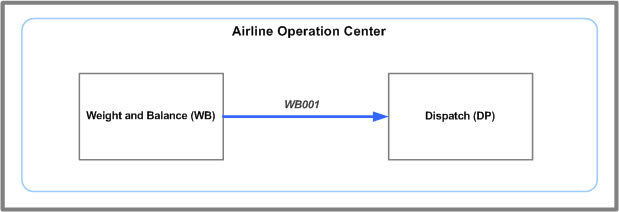
Figure 1. WB001 message system flow
3.1.3 Message Details
The following table provides details on the message version and includes links to the message’s technical specification.
Message Version |
WB001 v2 |
Message Header Details |
msgName: WB001 |
Message Specification |
|
Defined in XSD |
|
Sample Messages |
Samples not yet available for this message version. |
| Message Version History | No changes. |
3.2 WB002 - Payload and Weights
3.2.1 Message Overview
This message is used to publish discrete information related to a flight’s planned, released, or actual load plan. This information can then be used by other applications in the AOC.
There are three common business processes used to manage and publish load information:
- Centralized load planning
- De-centralized load planning
- Crew-calculated load planning
Each of these scenarios can utilize WB002 in one or more of its forms (planned, released, or actual).
3.2.1.1 Centralized load planning
When an airline’s load planning function and dispatch function are both located within the airline’s AOC, they can take advantage of centralized load planning. This allows the load planner and the dispatcher to work together when developing an optimized load plan. By including additional iterations during the load planning stage, last minute weight and balance errors can be avoided when actually loading the aircraft.
The following process, shown in Figure 2, provides one sample business flow for centralized load planning.
Create a load plan.
- Estimated weight is collected by the Weight and Balance system. This includes such things as booked passengers and booked cargo.
- Weight and Balance systems sends a tentative load plan to the Dispatch system using the WB002 (Planned).
- The Dispatch, Airport Analysis, and Weight and Balance systems and operators interact to optimize the flight and load plans.
For example, the dispatcher identifies the need for additional fuel for takeoff on the designated runway. The dispatcher communicates with the weight and balance operator to determine if they can drop some cargo to accommodate the extra fuel. They decide that rather drop the revenue-generating cargo, they can move to an alternate runway that requires less fuel.
Release a load plan.
- Dispatch system sends the fuel requirements to the Weight and Balance system using a DP002 (Publish Flight Plan) message.
- Weight and Balance system publishes a WB002 (Released) message approximately two hours before the flight.
Publish a final load plan.
- Actual weights are loaded into the Weight and Balance system. This includes actual passengers, fuel and cargo.
- Weight and Balance system sends the final load information to the Dispatch and other interested systems using a WB002 (Actual)

Figure 2 . Sample process for centralized load planning.
3.2.1.2 De-centralized load planning
When an airline’s load planning function and dispatch function are NOT both located within the airline’s AOC, then they will often follow a de-centralized load planning process. This process is similar to the centralized load planning approach, but often excludes the iterative optimization between Dispatch, Weight and Balance, and Airport Analysis system.
For example, many European airports have a Departure Control System (DCS), which includes a load control function. Therefore, the weight and balance calculations are separated from the airline’s flight planning and dispatch functions. In this case, the airline creates the flight plan and provides fuel requirements to the DCS. The DCS then computes the load plan.
Note: Because a third party is responsible for planning the flight’s load, it becomes more difficult to coordinate an optimal load strategy. Back and forth communication between the airline’s Dispatch and the DCS’s Weight and Balance systems can be inefficient or altogether absent.
The following process, shown in Figure 2 , provides one sample business flow for de-centralized load planning.
Decentralized systems gather and publish weight and balance information.
- Dispatch and Weight & Balance systems gather load and airport information separately. Which system collects which data is determined by the airline’s business processes and airport regulations.
- Dispatch system sends the fuel requirements to the Weight and Balance system using a DP002 (Publish Flight Plan) message. Note that this is the first interaction between the Dispatch and Weight and Balance systems.
Release a load plan.
- Weight and Balance system publishes a WB002 (Released) message approximately two hours before the flight.
Publish a final load plan.
- Actual weights are loaded into the Weight and Balance system. This includes actual passengers, fuel and cargo.
- Weight and Balance system sends the final load information to the Dispatch and other interested systems using a WB002 (Actual)
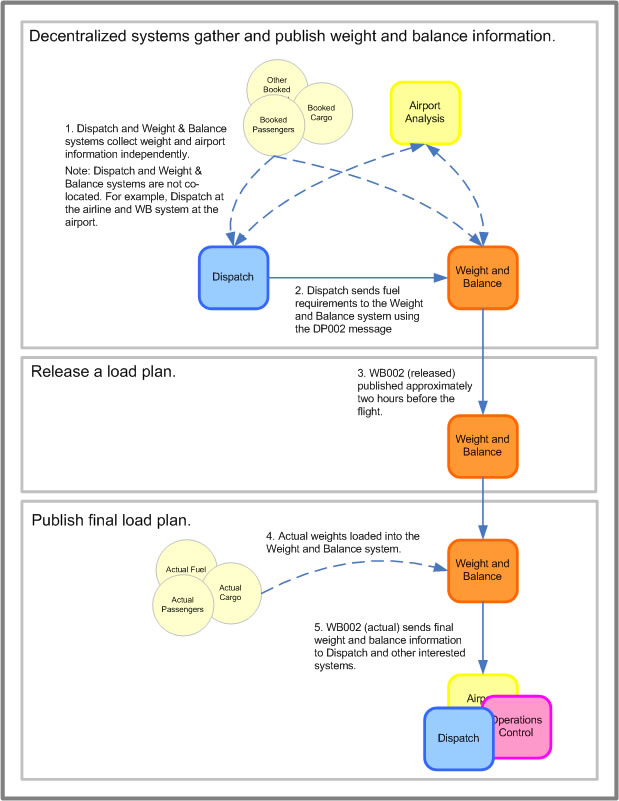
Figure 3 . Sample process for de-centralized load planning.
3.2.1.3 Crew-calculated load plan
To fulfill legal requirements, weight and balance paperwork must be completed before a flight. Many airlines select to prepare this load paperwork minutes before departure using the actual data that comes in sometimes minutes before departure. In this scenario, the airline forgoes the load planning stages and relies on a crew member or ramp personnel to complete the required paperwork.
Note: Although modern aircraft makes this a viable load-planning solution for many airlines, lack of pre-planning can lead to last minute load discrepancies and result in delays. For example, additional fuel was accidentally loaded onto the aircraft, pushing it above an acceptable weight. The flight must then take a delay as they de-fuel the plane or remove some cargo to bring the weight back into operational parameters.
The following process, shown in Figure 3 , provides one sample business flow for de-centralized load planning.
Weight and Balance information collected and calculated minutes before takeoff.
- Actual weights and final flight and airport information is given to a crew member to compute the aircraft’s weight and balance.
- Final weight and balance paperwork completed and filed. A WB002 (actual) message can then be sent to other interested systems.
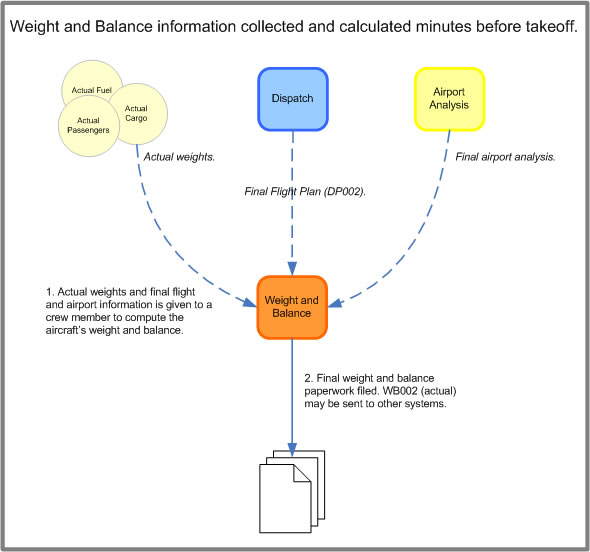
Figure 4. Sample process for a crew-calculated load plan.
3.2.2 Message System Flow
This message interacts with the systems as shown in Figure 5.
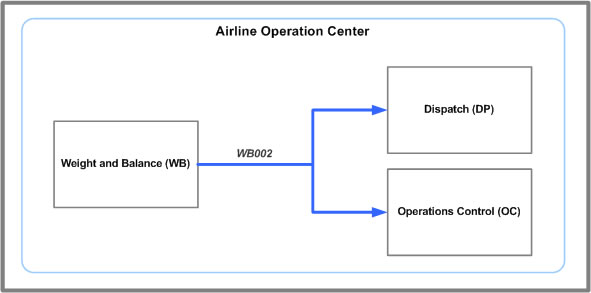
Figure 5. WB002 message system flow
3.2.3 Message Details
The following table provides details on the message and includes links to the message’s technical specification.
Message Version |
WB002 v2 |
Message Header Details |
msgName: WB002 |
Message Specification |
|
Defined in XSD |
|
Sample Messages |
|
Message Version History |
Version 1: |
3.3 WB003 - Actual Departure Fuel
3.3.1 Message Overview
This message allows an aircraft to communicate actual fuel on an aircraft at departure.
3.3.2 Message System Flow
This message interacts with the systems as shown in Figure 6.
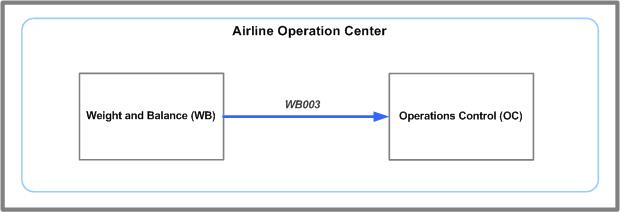
Figure 6. WB003 message system flow
3.1.3 Message Details
The following table provides details on the message version and includes links to the message’s technical specification.
Message Version |
WB003 v3 |
Message Header Details |
msgName: WB003 |
Message Specification |
|
Defined in XSD |
|
Sample Messages |
|
| Message Version History | Version 1:
Version 2: Version 3: |
3.4 WB004 - Load Calculation (Request / Response)
3.4.1 Message Overview
The message allows the dispatcher or load planner personnel to request a weight check to ensure that the estimated weights are within appropriate parameters.
3.4.2 Message System Flow
This message interacts with the systems as shown in Figure 7.
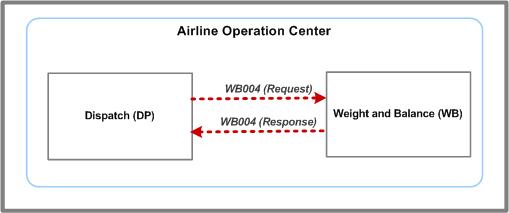
Figure 7. WB004 message system flow
3.4.3 Message Details
The following table provides details on the message version and includes links to the message’s technical specification.
Message Version |
WB004 v2 |
Message Header Details (REQUEST/RESPONSE) |
msgName: WB004 |
Message Specification |
WB004 LoadCalculationRequestType |
Defined in XSD |
|
Sample Messages |
|
| Message Version History | Version 2: |
3.5 WB005 - Warning Advisory (Request / Response)
3.5.1 Message Overview
This message allows a Dispatch system to monitor the actual weight of the aircraft as it is being loaded. The Dispatch system requests periodic updates during the loading process. The Weight and Balance system will then respond with a Warning Advisory when the aircraft has exceeded predetermined parameters.
3.5.2 Message System Flow
This message interacts with the systems as shown in Figure 8.
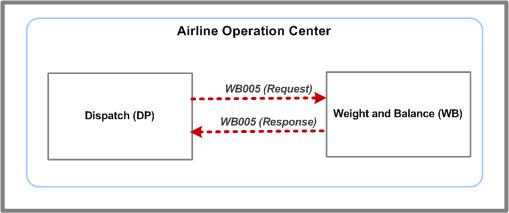
Figure 8. WB005 message system flow
3.5.3 Message Details
The following table provides details on the message version and includes links to the message’s technical specification.
Message Version |
WB005 v1 |
Message Header Details (REQUEST) |
msgName: WB005 |
Message Specification |
|
Defined in XSD |
|
Sample Messages |
WB005v1WarningAdvisoryRequest.xml |
| Message Version History | Updated message. |
3.6 WB006 - Payload and Weights (Request / Response)
3.6.1 Message Overview
This document is currently in draft - details and description of functions will follow.
3.6.2 Message System Flow
This document is currently in draft - details and description of functions will follow.
3.6.3 Message Details
The following table provides details on the message version and includes links to the message’s technical specification.
Message Version |
WB006 vA |
Message Header Details REQUEST) |
msgName: WB006 |
Message Specification |
WB006 PayloadWeightsRequestType |
Defined in XSD |
|
Sample Messages |
|
| Message Version History | Updated message. |
3.7 WB007 - Actual Arrival Fuel
3.7.1 Message Overview
This message allows an aircraft to communicate actual fuel on an aircraft at arrival.
3.7.2 Message System Flow
This document is currently in draft - details and description of functions will follow.
The following table provides details on the message version and includes links to the message's technical specification.
3.7.3 Message Details
Message Version |
WB007 vA |
Message Header Details |
msgName: WB007 |
Message Specification |
|
Defined in XSD |
|
Sample Messages |
|
| Message Version History | Updated message. |